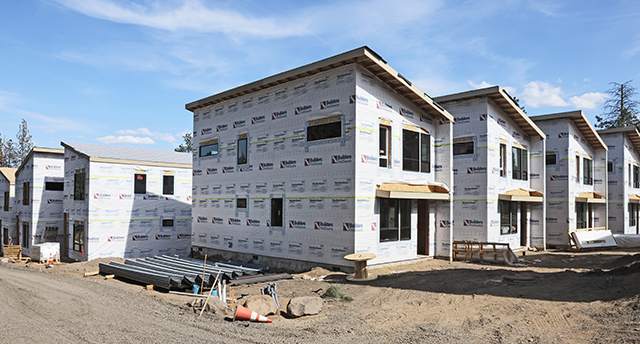A lot of lava, a lot of history
Published 5:00 am Wednesday, May 21, 2008

- A lot of lava, a lot of history
TULE LAKE (CA) — Mix history and geology, and they’re bound to start you thinking.
Historically, Lava Beds National Monument in extreme Northern California was ground zero for some large geology in the form of ancient volcanic upheaval. Later, it was the site of the only major Indian war fought in California. Today, a hike on one of the many trails within the monument puts you right there at the intersection of science and social studies.
This is forbidding country — all a’a lava (think overcooked brownies), sagebrush and hundred-mile vistas — where the beauty is harsh and the pickings slim. It’s amazing enough to picture people thriving in such an environment, but even more mind-boggling to imagine bullets flying.
Yet, that’s exactly what happened.
My first thought was that the Indians must have been sitting ducks out there in the lava. Not so. Hike a few miles and it becomes readily apparent that the trenches, tubes and seams provided excellent cover for Captain Jack and his small band of holdouts.
When the first flood of settlers arrived, the Modoc people had been living in scattered settlements along the shores of Tule Lake, up and down the Lost River and on the edges of the lava beds for a few thousand years. According to the National Park Service, the white newcomers demanded that the Modoc be removed from their homes and placed on the Klamath reservation to live side by side with the Klamath tribe, their historic enemy.
Kientpoos (Captain Jack to the settlers) and his fellow Modoc left the reservation twice, seeking their own on the Lost River. The second time, in the spring of 1870, Kientpoos and 371 Modoc headed south for the last time.
“On November 28, 1872, under orders from the Bureau of Indian Affairs, Major John Green sent troops from Fort Klamath to move the Modoc, ‘by force if necessary,’ back to the reservation,” according to the park service. “Many more Modoc were encountered than the Army had expected. Fighting soon broke out, and the Modoc fled as the troops burned their village.”
One band of Modoc retaliated, killing 14 male settlers, while Kientpoos led the rest of the exiles across Tule Lake and into the lava beds.
The stage for battle was set.
More than 300 troops and volunteers headed to the lava beds to convince 50 Modoc warriors to leave their stronghold and return with the women and children to the Klamath Reservation.
It all came to a head on Jan. 17, 1873, when the troops suffered “heavy losses” out there on the lava. Subsequent negotiations brought the two sides together at a predetermined spot, where Kientpoos again demanded a reservation at Lost River. The peace commissioners refused and Kientpoos drew a revolver and shot General Canby to death.
A surprise attack on the troops, a few days later, backfired on the Modoc and they were forced to retreat. Kientpoos surrendered on June 1, 1873. Kientpoos was hanged that fall.
In all, 53 U.S. soldiers, 17 civilians and 15 Modoc warriors were killed during the seven-month war.
Reminders of this culture clash are scattered across the monument. There’s Gillems Camp, where visitors can take a self-guided tour of what once served as the U.S. Army encampment. There’s a 4-mile, out-and-back trail to the battlefield and a butte — named after Modoc warrior Schonchin John — that looks like Pilot Butte and offers a ¾-mile hike and a view of the surrounding countryside. The nearby ice caves were heavily used by the Modoc when the Army cut off their water supply. And there’s obsidian on Glass Mountain, a Modoc source for tools and weapons.
On the Gillems Camp Trail, you’ll see a concrete foundation, all that’s left of a camp that housed 1,400 members of the Civilian Conservation Corps from 1935 to 1942. Members of the corps cleared entrances into lava tubes, built roads and built the Schonchin Butte Lookout, carrying all the materials to the top on their backs.
There’s also a fascinating visitor center that has sparked the interest of many a history buff, and the 43-site Indian Well Campground. There were a few RVs there last Thursday evening, but nothing too big; the roads are narrow and parking is tight. While the overall setting and individual campsites are somewhat secluded, the campground is far from primitive. There’s running water, fire pits and one of the nicest public campground bathrooms I’ve ever seen.
On the way back to Central Oregon, you might want to stop at the little Mexican restaurant in Merrill, south of Klamath Falls. Tacos Ala Mexicanna es muy bien.
If you go
Getting there: From Bend, drive south on U.S. Highway 97 to Klamath Falls. Continue, following the sign for Reno, Nev., and turn left at state Highway 39, which becomes California state Highway 139. Turn right at South County Road 111, then right at County Road 120 (Rim Road). Turn left at Hill Road. It’s about 160 miles one way. It took us about three hours to get to the campground.
Cost: Admission to the monument is $10 per vehicle for seven days. Campsite fee at Indian Well Campground is $10 per night (maximum 14 days).
Upcoming events: Interpretive programs will be offered Memorial Day weekend and the following weekend. Seven-day-a-week programs begin June 6. Beginning Friday, the monument’s visitor center hours will be extended to 8 a.m. to 6 p.m. for the summer.
Contact: 530-667-8100.







